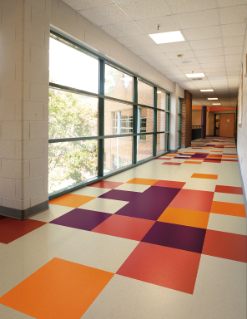As with any foundation, it starts from the ground up. The floor, which covers every square inch of a K-12 facility, can impact both a facility manager’s time and the bottom line. But choosing the right flooring is not always an easy choice. While there is no one-size-fits-all solution, the best practice for schools looking for new flooring is to evaluate product options based on three considerations: maintenance, longevity and sustainability. With these criteria as priority, K-12 school systems can choose building solutions designed with positive outcomes in mind.
Easy on Maintenance, Easy on Students
The benefit of considering maintenance when selecting flooring goes beyond reducing expensive protocols; it can contribute to and support a better learning environment overall. By specifying flooring products that provide ease of maintenance, a school’s staff can shift focus to maintain updated cleaning protocols in other areas of the facility.

Vinyl composition tile (VCT) flooring requires regular stripping, waxing and buffing with special equipment and harsh chemicals. This maintenance process can require significant labor costs and downtime to complete. What’s more, the process can release chemicals into the air, which can impact indoor air quality for the students, faculty and staff in the building.
By selecting flooring products that provide ease of maintenance, school systems can save time and money. For example, luxury vinyl tile (LVT) and rubber flooring solutions require little more than water and a mop, eliminating the need for stripping and waxing and contributing to a healthier built environment.
Latrobe Elementary School in Latrobe, PA, recognized the importance of selecting the right flooring for its new facility, prioritizing the need for durable floors that maintain their appearance and support the sustainable initiatives of the District – all while having a manageable life-cycle cost. Once installed, the custodial staff found that it was easier to maintain rubber flooring daily than the previous facility’s VCT and natural stones. At the new school, the maintenance staff does not have to manage multiple flooring types with various protocols.
Although LVT and rubber flooring may have a higher initial cost than VCT, testing indicates that under typical settings, it will result in a lower life-cycle cost through minimizing the cost of cleaning supplies, labor and pre-occupation cost.
The Benefits of Products that Last

The goal of school districts should be to select durable flooring that offers design flexibility and provides ease of maintenance as well as a good warranty. In the Fall of 2019, more than 56 million students attended elementary, middle and high schools, so flooring that can handle the wear and tear of constant foot traffic and still look good for years to come is required.
As heavy traffic puts daily stress on the floor, durability is crucial. And when sourcing flooring products, performance and design flexibility should be taken into consideration. Implementing a flooring system that withstands high-traffic areas, like rubber with superior wear and stain resistance, helps facilities meet space-specific needs that will look well-maintained for decades.
Modular flooring products, such as carpet tiles with glue-free installation, can also help maintain the flooring system by allowing for easy installation and replacement of single tiles even years later.

Extending Sustainability Commitments to the Built Environment
K-12 schools have the opportunity to teach students about climate change and to foster environmental responsibility among the next generation. As school systems work to share their sustainability mission with their student body, they should also consider how sustainability applies to their built environment. Facilities can be instrumental in lowering a school’s overall carbon footprint. In addition to minimizing the use of hazardous chemicals, the right flooring products can help facilities achieve a space that promotes the well-being of students, faculty and staff.
One way to manage a K-12 facility’s carbon footprint is by choosing vendors aligned to the school’s sustainability vision and mission.
One way to manage a K-12 facility’s carbon footprint is by choosing vendors aligned to the school’s sustainability vision and mission. When selecting a vendor, it is important to know what materials they use and how they are procured, as well as how much recycled content the products contain and if they offer a recycling plan. Some companies provide takeback programs like ReEntry™, which eliminates the landfill burden of flooring by reclaiming select carpet tile and LVT products.
What’s more, facilities can specify flooring that is carbon neutral across its full product life cycle. By evaluating the carbon footprint, life-cycle expectations and end-of-life solutions for flooring products, K-12 school facilities can successfully advance their sustainability journey while specifying a product that will withstand the test of time.

